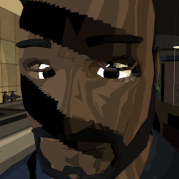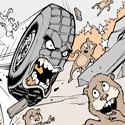|
roomtone posted:I'm having a tough time keeping motivation to learn and pursue 3D this week. I just got a little job and paid for doing something in 3D for the first time last week so you'd think I would be high on it, but I can't shake this feeling that the things I enjoy about the process are going to be completely gone by the time I finish my education, and it'll be something else entirely, and barely anybody will be hiring to do even that. I feel the same way sometimes, and I've been doing this stuff for over a decade. Not sure if I would put time into it if I was starting out at this moment in time. I do modelling which, for the time being, is probably less threatened than pure 2D work. Especially detailed, realistic, riggable modelling. What keeps me going, oddly enough, is clients and agencies being picky and indecisive. AI models can't interpret all their brain farts into meaningful feedback and then filter that through what's actually possible and won't look terrible and make the appropriate changes. I've had to change my brain to seeing notes as a good thing.
|
|
|
|

|
| # ? Apr 16, 2024 18:38 |
|
Colleagues at work were just talking about this last friday as there was a townhall with our CTO where he was celebrating how AI combined with the Omniverse will transform what we do. But then I actually talk to the software devs working on this stuff and they're like "oh yeah, well vfx companies right now have no money so maybe we'll be able to integrate some AI into some departments in 5 years, and Omniverse requires a USD pipeline, which we're not sure we'll ever be able to transition to," and so... This is a very legacy vfx company though. Maybe a new vfx company with no debt and a giant infusion of irrationally exuberant investor capital could get a pipeline full of AI tech and Omniverse USD interactive workflows off the ground?
|
|
|
|
They'll be eaten alive if they don't. Small teams can already compete with what it took a medium-large team to do 5-10 years ago. Small teams with AI and some funding could almost certainly compete with what it takes a medium sized traditional studio to do today. With some corners cut sure, but probably in places the consumers would barely notice. As for feelings of pessimism, I feel like part of the way to go is for stylization, at least in the medium term. Your life as a prop modeler, where it wasn't already gutted by outsourcing, is dead in the very near future. As a shader artist though you can do lots of things that AI trainers at least probably won't be prioritizing competing with for a little bit.
|
|
|
|
As someone that has been assessing current and future-potential AI tools for 3D production as part of my day job... your jobs are safe (mostly). The current industry-leader in the AI 3D space is still producing most of their content by real humans. I suspect they are using their current position as a leader to raise enough capital (and hopefully generate enough ARR from their store) in the hopes it keeps them afloat long enough for 3D AI to mature to where they can reduce their opex through reduction of their significant human labor. Even then, the results are "OK" at best. I still have a junior doing a ton of cleanup -- including UV's by hand -- because AI has no idea how to do that at all in a sensible way. Just to lay my credentials on the table so that people don't think I'm some rando: - 15+ years of experience in games as a 3D artist and tech artist working on props, environments, tech art, etc. on games including Grand Theft Auto, Red Dead Redemption, etc. - 5+ in the tech industry leading R&D teams on AR, VR, MR, spatial computing, automated photogrammetry and material scanning. - Several patents related to material scanning and photogrammetry and model generation A few off-the-cuff thoughts and comments about AI for 3D: 1. The more a company cares about quality and specific details, the less value they will get out of AI 3D modeling. I can't stress this enough. If your art director/client/stakeholder/whoever is really picky, then 3D AI will deliver increasingly less value. Your hero assets will need to still be made entirely by hand. 2. I think pretty much everyone looking at 3D AI generation is vastly underestimating the gulf in complexity from 2D -> 3D. Most are thinking it's a 2x jump in complexity from 2D, when in reality it's closer to 10x or even 100x. 3. Your jobs are "mostly" safe because the only jobs that are put more in danger are the low-level box-and-barrel prop makers. Those jobs were already in danger from outsourcing decades ago, and AI will put the squeeze on them even further. That said, companies will always need juniors to grow them into senior talent. Eliminating junior roles is incredibly short-sighted and will ultimately kill any business, and any industry, with 3D needs, the number of which is growing by the day (ROI on 3D imagery vs 2D imagery for consumer goods business is significantly higher than the cost of producing the content). 4. Smaller teams will see more value than the larger incumbents, but only in terms of quantity of output. Quality of output will still be significantly lower than with teams of experienced artists with an eye for quality. 5. Anything dealing with 2D is moderately at risk, but still needs a lot of touchup by an experienced artist. One note about this: the fundamental thing to consider about these AI tools is that you rarely get exactly what you want. You can only increase your odds of getting what you're looking for, but you're almost never able to get exactly what you want -- much like traditional outsourcing where better and more experienced outsource artists are more valuable. 6. As always, tools are temporary, fundamentals are forever. Companies will still need artists with solid fundamentals to work with whatever the AI spits out. It's not much different than the artistic skill needs around photogrammetry models, and mocap data. That is to say, great artists will turn that input into great assets, and bad artists will turn that input into bad assets. 7. Anyone saying that AI will transform what they do is, frankly, ignorant of the realities of a production environment that has to use 2D or 3D assets. Gearman fucked around with this message at 14:13 on Apr 10, 2024 |
|
|
|
Thanks for writing that up - it's encouraging to hear from someone in your position. I was thinking of emailing places near me I'd like to work to get a sense of how/if they are using AI, too. I also read an article yesterday which calmed me down a bit about it: https://www.wheresyoured.at/bubble-trouble/ I've been back at work on things today, my mind feels a bit cleared up, and hearing things from people who know a lot more than me is good.
|
|
|
|
I'm really interested in your perspective with your background in photogrammetry. With how advanced that's been getting particularly with 3D gaussian splatting and such just literally the past 6 months or so, I've been feeling like it's basically game over once it's actually editable and usable in a regular workflow, which can't be that far off. Use AI video gen to create a perfectly lit turnaround of any asset, then just use the already tested workflow to turn that video into 3D. Boom, you're basically done. In my head this sounds watertight and like the doom of all of us but then I've mostly only approached scanning and the like in my spare time as a hobbyist rather than for actual production.
|
|
|
|
roomtone posted:Thanks for writing that up - it's encouraging to hear from someone in your position. I was thinking of emailing places near me I'd like to work to get a sense of how/if they are using AI, too. That article aligns similarly with my experience in machine learning. I worked on a project where we leveraged synthetic training data (2D image renders) to help identify objects in an image because real images were 1) Hard to acquire in the format that we needed and 2) Photos still needed lots of manual work to do basic things like draw boxes around objects. The best results came from a dataset that used a mix of real data and synthetic data. The worst performer was the dataset that only used 2d renders. To add on to this, the available dataset of 3D assets is miniscule in comparison to the available datasets for text and 2D images. Even beyond that, 3D assets have many more specific needs than text and 2D. There is a massive gulf in the requirements of a dinosaur used for something like Jurassic Park, and a small toy dinosaur in a video game that sits on a shelf. All of the current AI 3D tools can kind of make the latter, albeit poorly, but none are anywhere even close to the former. The real value is in the former. Koramei posted:I'm really interested in your perspective with your background in photogrammetry. With how advanced that's been getting particularly with 3D gaussian splatting and such just literally the past 6 months or so, I've been feeling like it's basically game over once it's actually editable and usable in a regular workflow, which can't be that far off. Use AI video gen to create a perfectly lit turnaround of any asset, then just use the already tested workflow to turn that video into 3D. Boom, you're basically done. Gaussian splatting and AI video gen in general, I think have the same fundamental problem as technology like photogrammetry and VR: They all demo extremely well, but in practical use they have a lot of shortcomings. It's easy to get excited about them because they look so cool -- until you start having to use them or develop them outside of a demo environment. On gaussian splatting: It definitely looks very cool, but has the very same fundamental issues as photogrammetry: 1. It can only recreate something that already exists 2. The quality of the output is highly dependent on the quality of the input. 3. There is no easy way to get proper material definitions As a technology to quickly create an immersive version of a real thing, I think it's 100% cool and useful as a visualization tool, but with very limited use for asset creation. Companies like Zillow or RedFin will probably eat it up for walkthroughs of homes (they already do something similar to this with Matterport scanners, and gaussian splatting can use that same input data to make the experience more immersive at relatively little additional cost. Museums, or places looking to preserve things for historical purposes will also have a use for it as well. You'll likely see some small, and limited experiences built from them as well, but ultimately you'll likely see it used less than photogrammetry, which is still relatively niche compared to the vast quantities of 3D assets being created today by hand. AI video currently slams head-first into the problem of #2 from above, especially in terms of consistency from frame-to-frame. This is because one of the core requirements of photogrammetry, and data for gaussian splats, is imagery that is highly consistent from image to image. This is why anything that has a high level of reflection (mirrors, shiny car paint, chrome, etc.), transparency (glass of any kind), small thin pieces (plants with small needles, hairs, fur, etc.), anything that moves (humans, animals, things moving in the wind, etc. caveat here is that you can overcome this with a large number of cameras, which is why all head and body scanning rigs have dozens of cameras), anything that can't be easily seen by the camera or with small occluded areas (a barely open pinecone, or folds in a shirt) are all very poor candidates for photogrammetry. On top of that, you need really consistent lighting, which is why overcast days for outdoor scanning, or highly controlled indoor lighting environments are needed for even good results. Even the best AI really struggles with making a single 2D image without glaring errors. Most good 2D AI images still requires multiple passes with selections of certain areas to be regenerated to fix issues for any kind of art-directed requirement. The consistency between AI generated frames is significantly worse. In motion it looks kind of OK, but even half-decent artists can quickly spot all the glaring errors. If a human can see those errors, then the results for anything being generated with gaussian splatting and photogrammetry are going to be even worse. There are some very limited scenarios where I would say the results are kind of-ok, but that's when the subject is pretty far away from the camera, the camera is moving pretty quickly, and the animation is very short (a few seconds at most). After all of this there's still the fundamental problem of material definitions which are extremely difficult to get correctly and are a fundamental component of creating something that looks even somewhat correct. All of the current solutions for material definition generation, outside of the technically correct ones (using a system of dozens of lights and taking dozens of photos), are largely just making wild guesses based on values in the image, rather than what the materials in the image actually are. These are things like the image-to-material software packages you see either standalone or inside software like Substance Designer, Substance Sampler, etc. They all have no way of knowing what the material properties should be for certain materials in an image. Unfortunately, the training data necessary for this also exists in very small quantities and almost entirely within the walls of academic institutions. I haven't seen anything that really makes any significant headway here in a while. With all the big money and attention (which drives grants and thus academic research) being in AI 2D, 3D, animation and simulation, there's not much attention in this space so I don't expect to see much headway on it any time soon, either. Gaussian splatting + AI Video gen will likely only be game-over until it significantly improves and solves the consistency and material problems. People making quick and cheap content with largely off-the-shelf assets will see some value here, for sure. Anyone with high technical and artistic needs will not see much value from it, with early and fast concepting being the only real advantage they could conceivably leverage. Gearman fucked around with this message at 16:29 on Apr 10, 2024 |
|
|
|
Apologies for the double-post here, but with all the discussion around AI, I think it's warranted to have a separate post for my call-to-action for anyone working in the arts or thinking about art as a career: 1. If you like art, if you enjoy making art, DON'T STOP MAKING ART. We all have something to say, and in my case, I'm more of a show-don't-tell kind of person. My writing sucks, and I communicate better with pictures -- he says as he communicates entirely in text on some old forums. Without the ability to make art, I don't have much of a voice. Art, made by humans, is important. 2. If you want to have a career making art, FOCUS ON THE FUNDAMENTALS. Tools are temporary, fundamentals are forever. Focus on the basics of things like light, form, color theory, contrast, repetition, etc. New software comes and goes every week, but sound fundamentals always transfer over and make a difference. Craig Mullins pastes photos on a canvas in Photoshop and is one of the most highly sought-after artists in the world, because he is also an incredibly good artist. I've probably spent, collectively, a year of my life looking at portfolios just begging for a morsel of evidence that the artist has sound fundamentals. It's easier, and getting easier, to make art now but it's still hard to make good art. 3. Develop an EYE FOR QUALITY. Being able to tell when something is bad, and knowing how to fix it is extremely valuable. This is something many juniors lack, and really only comes through experience. People that have good taste are immediately recognizable over those that don't. This will always have value. 4. If you're afraid of something, LEARN MORE ABOUT IT. AI was really scary to me a few years ago. Now that I've really dug into it, it's not so scary and I realize just how much it falls short. Similarly, I love photogrammetry, and that had a lot of people worried about losing their job, too. Today, most people understand the positives and negatives of photogrammetry and no one has lost their job over it. Ok, maybe that one guy who only knows how to do photogrammetry and refuses to learn anything else. Don't be that guy. 5. Accept that some jobs WILL BE DIFFERENT. There are now animation jobs that are largely mocap cleanup. Some jobs that are just taking assets from Quixel and shoving them into Unreal. Soon there will be some jobs where you're just touching up AI images, or AI models. I don't believe this will lead to the downfall of the role of production artists. There will still be jobs, but some will be different. I firmly believe this to be true. There are many other important points I'd like to make, which at this point I should probably just package up into a GDC talk, but I think these are the most important for anyone grappling with the world as it is today and the evolving nature of AI. It's new, and somewhat scary, but it's going to be OK. Good artists are still going to be very employable. Gearman fucked around with this message at 16:02 on Apr 10, 2024 |
|
|
|
Good posting German, thanks for making the effort
|
|
|
|
Slothful Bong posted:As to the “why” of it all, my in-the-dark assumption is it’s due to outside investors. When you get tech investment firms dumping millions into VFX companies specifically for AI, they’ll never get the gains they want, and then the company is on the hook for showing “profitability” in the short term. Woof. One reason I ran screaming from film VFX was that no one makes money on it. Investing in VFX is a quick way to turn a million dollars into a hundred dollars. I still laugh when Sony tried to sell Imageworks for something like 600-800M back in the late 00's and no one was having it... the tech stack/pipeline wasn't worth that, and it was cheaper just to hire away the talent and roll up a new studio. It's a gold rush, so it may be better invest in shovel companies or sell the equipment to gold miners... so in this case the safe investment is to just buy Nvidia stock 
|
|
|
|
The fact that no one makes money on vfx is what probably exhausts me the most. But it's been amped up to 11 in the past 6 months as studios stop winning projects and have to somehow afford upkeep with only the current shows. More than just deadlines, the fact that everything is always a push for approvals as fast as possible just so they can get than next payment and keep the ship afloat. Like its not about working on a shot to get it to the point that we say "yes, this is good, the client will really like this," it's more like "alright, we gotta get something out, just send it, maybe they'll approve it and we can afford to keep someone for one more week." And if quota gets missed, well, then they have to let someone go because they just don't have the bank balance anymore.
|
|
|
|

|
| # ? Apr 16, 2024 18:38 |
|
Gearman posted:There are many other important points I'd like to make, which at this point I should probably just package up into a GDC talk, but I think these are the most important for anyone grappling with the world as it is today and the evolving nature of AI. It's new, and somewhat scary, but it's going to be OK. Good artists are still going to be very employable. I really think hybrid live-action+CGI+AI is gonna be the future. The AI filmmakers out there (at least the ones making anything remotely interesting) have already been doing this.
|
|
|












